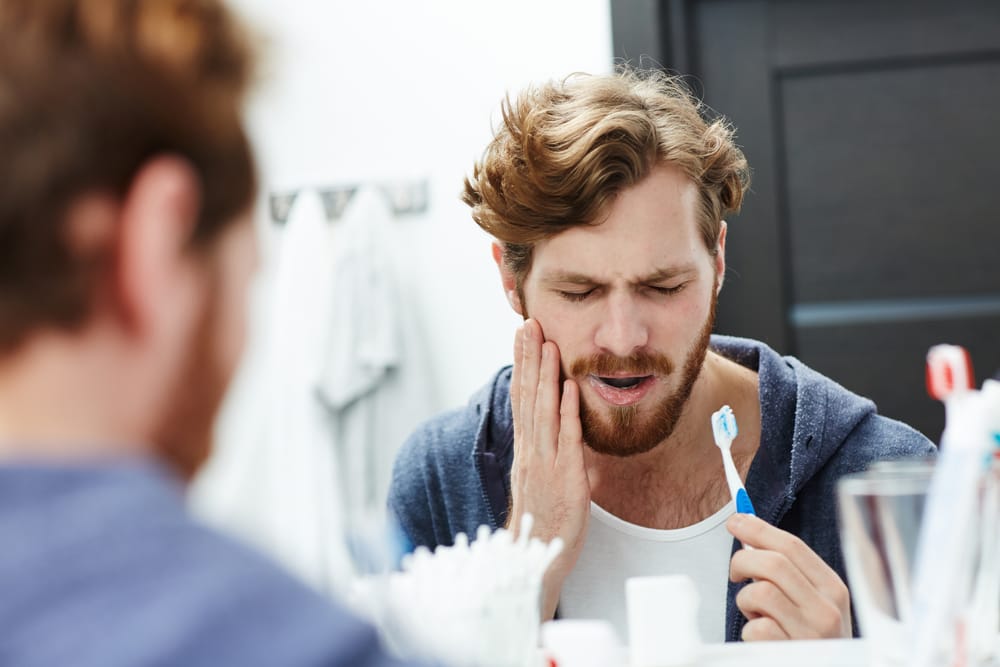The Ultimate Guide to Tooth Decay
You take a sip of your ice cold drink and you feel a sudden sharp pain in one of your teeth. A few days later, your tooth is throbbing and it hurts to chew. At this point, you probably suspect you have a dental cavity.
If you do, you’re not alone. Tooth decay is hands down the most common dental problem our Mission Viejo and San Clemente general dentists see at our practice. In fact, the National Institute of Dental and Craniofacial Research found that 92% of adults ages 20 to 64 have had cavities in their permanent teeth.
The good news is, decay is preventable, and when caught early, it can be simple to treat. The team here at Shoreline Dental Studio will be covering everything you need to know about tooth decay from what causes it to how to tell if you have a cavity.
What is Tooth Decay?
According to the American Dental Association, tooth decay “is the destruction of your tooth enamel, the hard, outer layer of your teeth.” Are tooth decay and cavities the same thing? No, but cavities are the result of tooth decay. Tooth decay, or dental caries, is the bacterial disease process that damages a tooth. As tooth decay progresses, a hole can form in the enamel. This hole is a cavity.
What Causes Tooth Decay?
How does tooth decay happen? It starts with plaque. Plaque is a sticky bacterial film that constantly forms on your teeth as the bacteria in your mouth mix with saliva, acids, and food particles. The plaque bacteria then feed on sugars and starches from the things you eat and drink, and when they do, they release acids that attack enamel.
These acid attacks leach minerals from your tooth enamel, a process known as demineralization. Then, the minerals in your saliva, as well as fluoride, help to deposit minerals back into the enamel (remineralization). When demineralization wins the battle against remineralization, tooth decay occurs and, eventually, cavities can develop. Because plaque is so sticky, if it’s not brushed and flossed away, it keeps acids in constant contact with your enamel, speeding up the process of tooth decay.
While, ultimately, it’s plaque accumulation and acid attacks that cause tooth decay, there are a number of things that can increase your risk of cavities, including:
- Poor oral hygiene – Controlling plaque is the key to avoiding cavities. When plaque isn’t regularly removed with brushing and flossing, it clings to the teeth and the acids damage the enamel. Over time, plaque hardens into tartar, or calculus. Tartar can’t be removed with regular brushing and flossing. As it builds up on the teeth and around the gumline, it stays there, releasing acids until you have it removed during a professional dental cleaning.
- Gum recession – Whether from brushing too hard, irritation from plaque and tartar, or gum disease, gum recession is common, especially as you get older. As the gums recede, cavity-causing bacteria come into contact with the exposed root surfaces of the teeth, potentially causing root decay.
- Loose dental restorations – If a dental restoration, such as a filling, dental crown, or a bridge, is damaged, loose, or doesn’t fit properly, plaque bacteria can hide out in the cracks and crevices. As acid builds up, it leads to tooth decay.
- Diet – Sugary and starchy foods and drinks feed the bacteria in the mouth causing them to release acids. Acidic food and beverages can also contribute to cavities by accelerating the erosion of your enamel.
- Health conditions and medications – Certain health conditions and medications cause dry mouth. When you suffer from dry mouth, you don’t produce enough saliva to wash away plaque and food debris and help remineralize the tooth enamel. If not addressed, dry mouth can significantly increase your risk of cavities.
- Frequent snacking and sipping – When it comes to the causes of tooth decay, how often you eat is almost as important as what you eat. It takes about 30 minutes after eating or drinking for your saliva to neutralize the plaque acids and the pH in your mouth to return to normal. Every time you take a bite of food or a sip of a drink (aside from plain water), it starts the clock over again and interferes with the remineralization process, giving demineralization the edge. Eventually, this will cause tooth decay and cavities.
How Can I Tell if I Have a Cavity?
Early tooth decay that occurs on the outer enamel layer doesn’t usually cause pain. As it progresses and you get decay in the dentin or tooth roots, you will likely have telltale cavity symptoms, such as:
- Toothache (you may have severe, throbbing tooth pain or sharp pain that comes and goes)
- Pain when biting or chewing
- Sensitivity to sweets and hot or cold foods and drinks
- Bad breath or a bad taste in the mouth
- Facial swelling
- Bleeding gums
- Redness in the mouth
- Tooth discoloration
While these symptoms are an indication that something is going on in your mouth, the only way to know for certain whether or not you have a cavity, is to visit your dentist. When a patient comes to us with symptoms like tooth pain in Mission Viejo or San Clemente, a team member takes digital x-rays. Then, Dr. Ritzau, Dr. Livingston, or Dr. Saad performs an exam and assesses the x-rays to accurately diagnose tooth decay.
What Happens if I Don’t Have Tooth Decay Treated?
The earlier you seek treatment for tooth decay, the easier and more affordable treatment will be. An untreated cavity will continue to get larger and weaken the tooth. The tooth is then at risk of breaking or fracturing. Treating a very large cavity will also require removing more tooth structure or, sometimes, an extraction.
Severe, untreated cavities may cause infection as well. When a tooth is infected, a pocket of pus, called an abscess, can develop that leads to severe pain, facial swelling, and fever. The infection is considered a dental emergency, because it can spread to other areas of the body.
Can You Reverse Tooth Decay?
Yes, you can reverse very early tooth decay. Once tooth decay creates a cavity, however, the damage is permanent and will need to be repaired. To reverse early tooth decay, we may use fluoride or another treatment to remineralize the tooth. Replacing the lost minerals will strengthen the weakened enamel and prevent a cavity from forming.
It’s important to note that when tooth decay is in a stage where it’s still reversible, it doesn’t usually have symptoms. It’s during regular dental exams and cleanings that your dentist is able to catch the first signs of a problem. This highlights the importance of having an exam and cleaning once every six months, or as often as your dentist recommends.
What are My Tooth Decay Treatment Options?
The treatment used will depend on how severe your tooth decay is. Common cavity treatments include:
- A Composite Filling – When you come in for a filling, your Orange County dentist will remove any decay and clean and condition the affected area. They’ll then fill in the space left behind with composite filling material that’s color matched to your smile. After curing the filling with a blue light, they’ll shape and polish the filling so that it’s completely undetectable. Not only does the filling restore the appearance of your tooth, it also prevents bacteria from accumulating in the space, offering some protection against future decay.
- A Dental Crown – If your tooth doesn’t have enough natural structure left to support a filling, a dental crown will be necessary. After removing decay and taking digital impressions, the dentist will gently shape the tooth so that a dental crown, or cap, can fit over it. They’ll place a temporary crown on the tooth and send your information to a specialized lab. A lab technician will create a high quality, porcelain crown that mimics the appearance of a natural tooth down to the way it reflects light.
When your permanent restoration is ready, you’ll come back to the office. Dr. Ritzau, Dr. Livingston, or Dr. Saad will remove your temporary and have you try the permanent crown. Once they’re happy with the fit and appearance, they’ll bond it in place. Lastly, they’ll make any minor adjustments to your bite and give the crown a final polish for the most natural look.
- A Root Canal – If you have root decay or an infection in the pulp, a root canal will eliminate pain and may help save your tooth. During a root canal, your dentist will carefully remove the tooth’s pulp, which contains the nerve endings, and clean and disinfect the inside of the tooth. They’ll then fill and seal the area. Since a root canal can make your tooth more fragile, a dental crown is often placed to protect the tooth and restore its strength, appearance, and function.
- Tooth Extraction – In extreme cases, when a tooth is severely decayed and/or infected and can’t be saved, an extraction might be necessary. At Shoreline Dental Studio, we offer a range of tooth replacement options, including dental bridges and dental implants. We’ll help you decide on the best way to replace your tooth after the extraction in order to preserve your oral health.
How Can I Prevent Cavities?
While we pride ourselves on providing painless, gentle care and a relaxing experience (hello, comfort menu), the truth is, prevention is always better than treatment. Preventing cavities will help you maintain excellent oral health and, in turn, overall health. Not to mention, it will also save you time and money.
Here are 7 things you can do to prevent tooth decay:
- Brush your teeth at least twice a day for two minutes each time using a soft-bristled toothbrush and fluoride toothpaste.
- Floss once daily. If you have a dental bridge or wear braces, use a floss threader to work the floss under your restoration or brackets and wires. If you’re at risk for tooth decay or find that you still have lingering plaque, you may want to add a water flosser to the mix. A water flosser, or Waterpik, is an excellent tool for getting rid of stubborn plaque and food debris that you may have missed while flossing.
- Eat a healthy, well-rounded diet. Limiting your intake of processed foods, simple starches like white bread and potato chips, sugary treats, sticky foods, soda, and other sugary beverages will help to keep cavity-causing acids in check. Enjoy acidic food and drinks in moderation too. Since the acidity temporarily weakens your enamel, rinse your mouth out after having something acidic, such as orange juice or coffee, but wait an hour before brushing your teeth. Otherwise, you can inadvertently damage your enamel.
- Speaking of diet, minimize your snacking and sipping. Frequent eating and drinking contributes to repeated cycles of acid attacks. Drink water throughout the day, and if you do have a special beverage, enjoy it one sitting. The same goes for snacks. Have sugary or starchy foods as part of a larger meal. When you do need a snack outside of meal times, eat something smile-friendly and, as soon as you’re done, put it away instead of leisurely munching.
- Keep up with your regular dental exams and cleanings. During a dental cleaning, the hygienist uses special tools to remove tartar (hardened plaque) that you can’t get rid of at home. This helps to keep tooth decay and gum disease at bay.
A dental exam is just as important. A team member will take digital x-rays and, once a year, a three-dimensional digital dental health scan. The diagnostic records combined with a thorough exam allow the dentist to address any issues like tooth decay in their earliest stages, sometimes while it’s still reversible.
Another important aspect of getting routine dental care is that our dental team can give you personalized recommendations to follow. They might recommend a specific tool, toothpaste, or rinse that will bolster your cavity prevention efforts.
- Chew sugarless gum after meals to stimulate saliva production. Saliva washes away plaque and food particles and kicks off the remineralization process. Bonus points if the gum contains xylitol, which is thought to decrease the amount of decay-causing bacteria in the mouth.
- Talk with your dentist about treating dry mouth. It could be as simple as switching medications or staying hydrated by drinking plenty of water. Or, they might suggest certain oral health products.
Suffering From Tooth Pain in Mission Viejo or San Clemente, CA?
If you have tooth pain or signs of tooth decay, schedule an appointment with a Mission Viejo or San Clemente general dentist at Shoreline Dental Studio today! Our expert dentists will get to the bottom of the problem and deliver gentle, personalized treatment to restore your smile.




